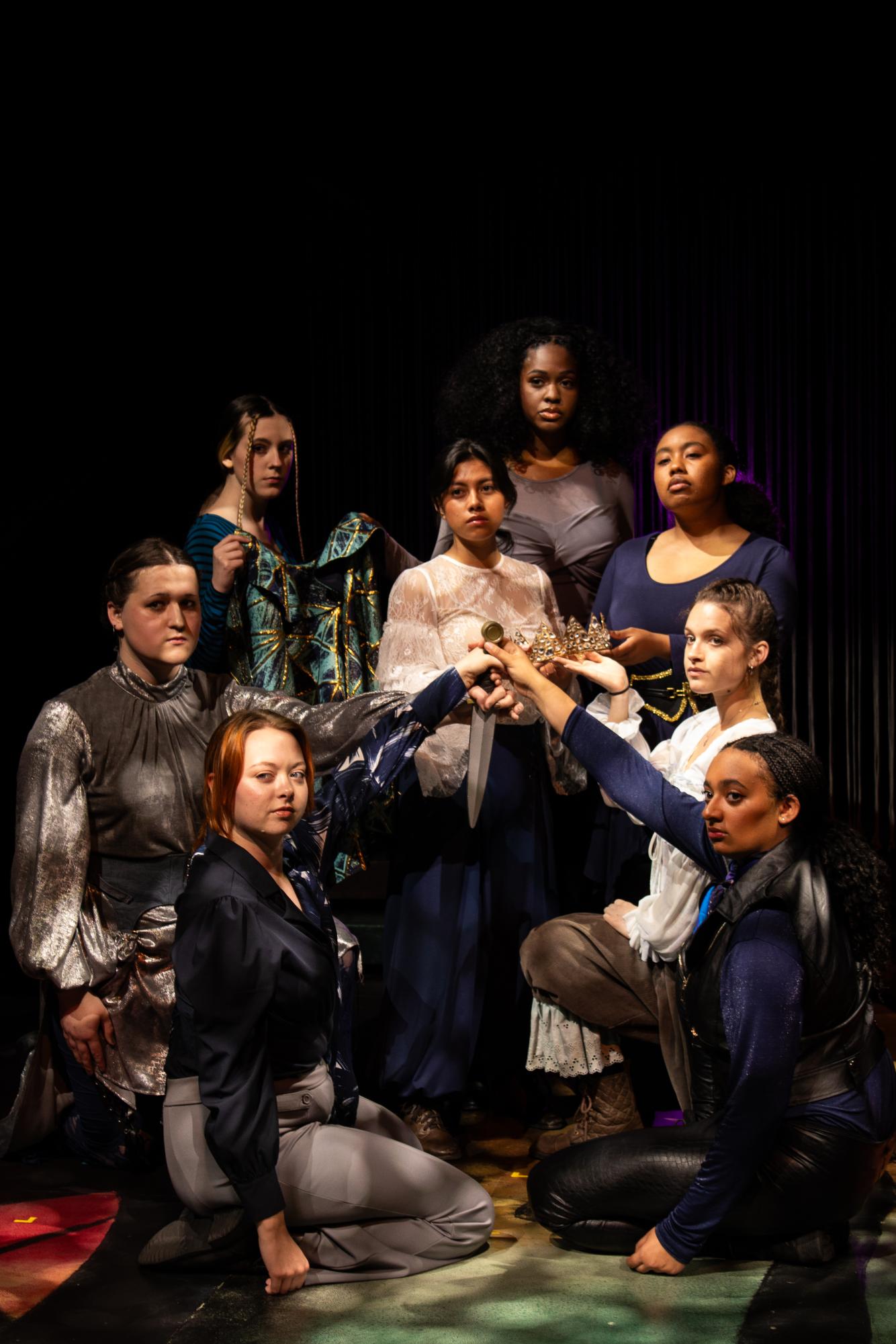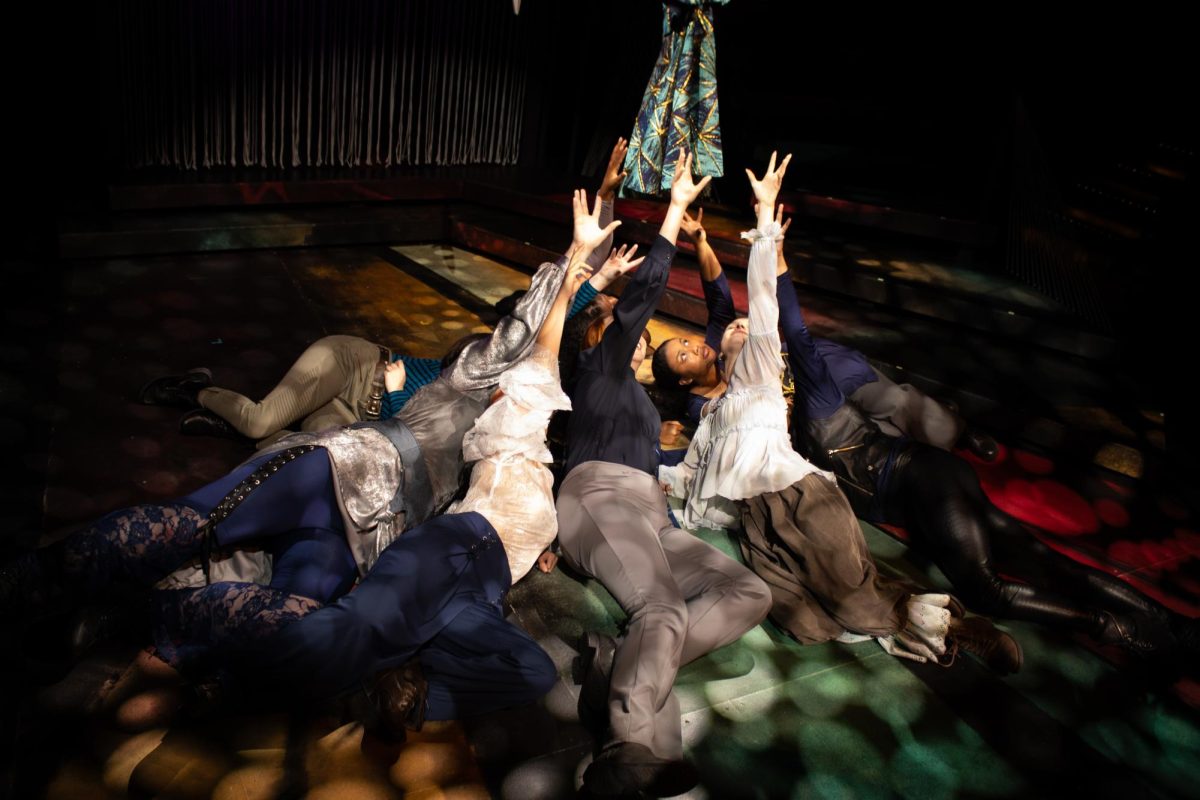Out of every dramatic role in theater, there is arguably none more well-known or complex than Hamlet. As the character with the most lines out of any Shakespearean play, whose descent into madness and passionate soliloquies (“To be or not to be,” anyone?) have inspired countless pop culture references, the role is coveted for any actor. Or, in a recent student adaptation, actors.
“That nuance in Hamlet’s character is exactly why we have eight of him,” assistant director and San Diego State University theater student Wren Leesonne said. “We’re breaking apart the different facets of his personality and using a different actor to really dig in.”
For a 400-year-old play, it’s difficult to take on the story in a way that hasn’t been done before. When SDSU’s School of Theatre, Television, and Film took on the play, director Dani Bedau envisioned a physical interpretation of Hamlet’s mental state— fragmented in his anger, grief and loneliness.
The classic Shakespearean tragedy follows Prince Hamlet of Denmark as he grieves over the death of his father and the jarring remarriage of his mother to his uncle Claudius. A ghost of his father, King Hamlet, appears to the prince and reveals that he was killed by his own brother, Claudius. Prince Hamlet embarks on a doomed path of revenge that leads to his downfall.
Stage manager and SDSU junior Amelia Simpson said that the use of many Hamlets fostered stronger solidarity and creative expression among the cast in a usually isolating role.
“No one was bearing the burden of that role alone. (Playing Hamlet) is incredibly difficult. If you were doing the full text and you’re the only person playing Hamlet, your character is in a very vulnerable and volatile mental state for almost the entire play,” Simpson said. “So much of the play is you against everyone else. There’s so much time on stage that he spends alone. This way, each person brings something different.”

Stephanie Norris plays several roles within SDSU Theatre’s ‘Hamlet,’ including Rosencrantz, Hamlet’s childhood friend turned spy, and Bernardo, a soldier. Having only ever acted in a Shakespeare play once before, the SDSU senior was fascinated by the exploration of many characters.
“I’ve definitely still had to do a lot of work with changing my voices and changing my physicality. Finding those different characterizations has been a little bit tricky but also fun because you get to play around with different people,” Norris said.
Norris has another role: Prince Hamlet himself. Specifically, Hamlet #7.
“We (as actors) all have things that we take from each other and things that we kind of share through all the Hamlets, but each Hamlet has slightly different characteristics, whether impulsive, or thoughtful or mean,” Norris said. “It’s been really interesting to see how grief impacts the Hamlets in that way.”
She isn’t the only female Hamlet in the cast— each of the eight actors is female, further twisting the original narrative.
Director Dani Bedau is an SDSU associate professor with longtime experience directing theater. She says the statement the production makes has only become more relevant.
“When we chose to do this play, we didn’t know what was going to be going on in the world. Now, it’s just a little more important to be making art that has meaning,” Bedau said. “You know, we got eight female Hamlets. To be making a production of Hamlet that says, we’re doing it a different way, seems more important than ever.”
Rather than for shock value or a forced modern take, Brooke Ann Schrock, who plays Hamlet #3, contends that the choice points out the gendered internal battle of the character.
“Gender roles aren’t explicitly the main theme of ‘Hamlet.’ Hamlet himself doesn’t exactly fit neatly into gender roles. Claudius, his uncle, literally calls his grief ‘unmanly.’ Hamlet refers to his inner self as being feminine. There’s a lot of stuff in this play about women being emotional and having to force that feminine side out of yourself so that you can do your duty,” Schrock said. “I think that by having all women playing Hamlet, it just lets us notice that more easily.”

In fact, many scholars agree that ‘Hamlet’ is a commentary on gendered notions of one’s identity, among other themes. This production is part of a long legacy of female Hamlets for this exact reason. One such Shakespeare scholar, Guo De-Yan, argues that Hamlet’s insecurity with the feminine and masculine sides of his character is what leads to his mental breakdown over the course of the play.
Leesonne added that exploring identity through gender within ‘Hamlet’ is a unique challenge as a transgender man and first-time assistant director. He describes drawing upon his own life experience to prepare the actresses for stepping into a male role.
“Having grown up in female culture and then transitioning into male culture, it’s been an interesting look at what perception of gender identity kind of does to an individual, which is not necessarily the main focus of our ‘Hamlet,’ but it is important to the actors who are playing him,” Leesonne said.
Besides identity, Leesonne says their main focus in the production is generational trauma and the ramifications of loss.
“There’s something about the burden that children have to bear for the sins of their parents. Then the fracturing that can happen after there’s been a loss of a parent, especially with Hamlet, where he finds out about his uncle’s betrayal and further spirals,” Leesonne said. “We wanted to emphasize that.”
Simpson adds that the fracturing of Hamlet’s mind was also illustrated in the set itself.
“We were inspired by German expressionism a little bit for the shape of the set. One of the core images that’s come up in this show has been the idea of fractures,” Simpson said. “So there are these really cool set pieces, like an asymmetrical, irregular set of stairs and then these protruding displays. There’s a paint treatment on the floor that looks like shattered stained glass.”
The “stained glass” effect of the set creates a bold palette of red, gold, blue and green in a traditionally dark play. For a tragedy known for using black, Norris said the use of color portrays the “disrupted, chaotic, emotional minds of the characters.”
“We (the Hamlets) even pass around a cloak that looks as if it were made of the same stained glass as the set, but gilded in gold,” Schrock said. “As if it were a representation of Hamlet himself, and his place as prince.”
This shattered, emotional and ‘feminine’ Hamlet is what many in the cast agree will be most exciting to see onstage.
“I’m really excited for people to see the set and the actors diving into the role because I think it will surprise them,” Norris said. “It’ll give them a different sort of gateway into this famous character and well-known show.”
SDSU School of Theatre’s production of Hamlet opens on the Prebys Stage on April 10, 2025.








